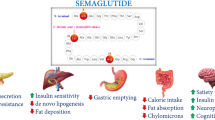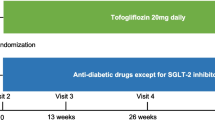Abstract
The proposed objective of this study is to attenuate cardiac fibrosis by inhibiting NLRP3 inflammasome and related genes in uninephrectomized-DOCA fed rat model. Cardiac fibrosis was induced in male Sprague Dawley rats by uninephrectomy and by subsequent administration of deoxycorticosterone acetate (DOCA) every 4th day till 28 days along with 1% NaCl in drinking water. Further, the animals in treatment groups were treated with Glibenclamide (10, 20 and 40 mg/kg) for 28 days which was selected based on docking study. Interim analysis was carried out on the 14th day to assess the hemodynamic parameters. On the 28th day, anthropometric, hemodynamic, biochemical and oxidative stress parameters, gene expression (TGF-β1, pSmad 2/3, NLRP3, IL-1β and MMP-9), ex vivo Langendorff studies and Masson’s trichrome staining of heart was carried out. Results were interpreted using ANOVA followed by post hoc Bonferroni test. Glibenclamide treatment significantly reduced the increase in blood pressure. Furthermore, the ECG patterns of the treatment groups displayed a lower frequency of the slow repolarizing events seen in the model animals. Moreover, Glibenclamide treatment demonstrated normal LV function as evidenced by a significant decrease in LVEDP. Besides, this intervention improved the anthropometric parameters and less collagen deposition in Masson’s trichrome staining. The cascade of TGF-β1-pSmad2/3-NLRP3 was downregulated along with suppression of IL-1β. Our study repositioned anti-diabetic drug Glibenclamide to treat cardiac fibrosis by inhibiting the TGF-β1-pSmad2/3-NLRP3 cascade.
Graphical abstract















Similar content being viewed by others
Data availability
The datasets generated during and/or analyzed during the current study are not publicly available, but are available from the corresponding author on reasonable request.
References
Thannickal VJ, Zhou Y, Gaggar A, Duncan SR (2014) Fibrosis: ultimate and proximate causes. J Clin Invest 124:4673–4677. https://doi.org/10.1172/jci74368
Friedman SL, Sheppard D, Duffield JS, Violette S (2013) Therapy for fibrotic diseases: nearing the starting line. Sci Transl Med 5:167sr1. https://doi.org/10.1126/scitranslmed.3004700
Hinderer S, Schenke-Layland K (2019) Cardiac fibrosis - A short review of causes and therapeutic strategies. Adv Drug Deliv Rev 146:77–82. https://doi.org/10.1016/j.addr.2019.05.011
Gourdie RG, Dimmeler S, Kohl P (2016) Novel therapeutic strategies targeting fibroblasts and fibrosis in heart disease. Nature reviews Drug Discov 15:620–638. https://doi.org/10.1038/nrd.2016.89
Frangogiannis NG (2020) Transforming growth factor–β in tissue fibrosis. J Exp Med. https://doi.org/10.1084/jem.20190103
Alyaseer AAA, de Lima MHS, Braga TT (2020) The Role of NLRP3 inflammasome activation in the epithelial to mesenchymal transition process during the fibrosis. Front Immunol. https://doi.org/10.3389/fimmu.2020.00883
Mezzaroma E, Abbate A, Toldo S (2021) NLRP3 inflammasome inhibitors in cardiovascular diseases. Molecules. https://doi.org/10.3390/molecules26040976
Pan X-C, Liu Y, Cen Y-Y, Xiong Y-L, Li J-M, Ding Y-Y, Tong Y-F, Liu T, Chen X-H, Zhang H-G (2019) Dual role of triptolide in interrupting the NLRP3 inflammasome pathway to attenuate cardiac fibrosis. Int J Mol Sci 20:360. https://doi.org/10.3390/ijms20020360
Qiu Z, Lei S (2017) NLRP3 inflammasome activation-mediated pyroptosis aggravates myocardial ischemia/reperfusion injury in diabetic rats. Oxid Med Cell Longev 2017:9743280. https://doi.org/10.1155/2017/9743280
Mariathasan S, Weiss DS, Newton K, McBride J, O’Rourke K, Roose-Girma M, Lee WP, Weinrauch Y, Monack DM, Dixit VM (2006) Cryopyrin activates the inflammasome in response to toxins and ATP. Nature 440:228–232. https://doi.org/10.1038/nature04515
Mezzaroma E, Toldo S, Farkas D, Seropian IM, Van Tassell BW, Salloum FN, Kannan HR, Menna AC, Voelkel NF, Abbate A (2011) The inflammasome promotes adverse cardiac remodeling following acute myocardial infarction in the mouse. Proc Natl Acad Sci U S A 108:19725–19730. https://doi.org/10.1073/pnas.1108586108
He Y, Zeng MY, Yang D, Motro B, Núñez G (2016) NEK7 is an essential mediator of NLRP3 activation downstream of potassium efflux. Nature 530:354–357. https://doi.org/10.1038/nature16959
Lima H Jr, Jacobson LS, Goldberg MF, Chandran K, Diaz-Griffero F, Lisanti MP, Brojatsch J (2013) Role of lysosome rupture in controlling Nlrp3 signaling and necrotic cell death. Cell Cycle 12:1868–1878. https://doi.org/10.4161/cc.24903
Chu J, Thomas LM, Watkins SC, Franchi L, Núñez G, Salter RD (2009) Cholesterol-dependent cytolysins induce rapid release of mature IL-1beta from murine macrophages in a NLRP3 inflammasome and cathepsin B-dependent manner. J Leukoc Biol 86:1227–1238. https://doi.org/10.1189/jlb.0309164
Gao P, He FF, Tang H, Lei CT, Chen S, Meng XF, Su H, Zhang C (2015) NADPH oxidase-induced NALP3 inflammasome activation is driven by thioredoxin-interacting protein which contributes to podocyte injury in hyperglycemia. J Diabetes Res. https://doi.org/10.1155/2015/504761
Gan W, Ren J, Li T, Lv S, Li C, Liu Z, Yang M (2018) The SGK1 inhibitor EMD638683, prevents Angiotensin II-induced cardiac inflammation and fibrosis by blocking NLRP3 inflammasome activation. Biochim Biophys Acta Mol Basis Dis 1864:1–10. https://doi.org/10.1016/j.bbadis.2017.10.001
Willeford A, Suetomi T, Nickle A, Hoffman HM, Miyamoto S, Heller Brown J (2018) CaMKIIδ-mediated inflammatory gene expression and inflammasome activation in cardiomyocytes initiate inflammation and induce fibrosis. JCI Insight. https://doi.org/10.1172/jci.insight.97054
Wang Y, Wu Y, Chen J, Zhao S, Li H (2013) Pirfenidone attenuates cardiac fibrosis in a mouse model of TAC-induced left ventricular remodeling by suppressing NLRP3 inflammasome formation. Cardiology 126:1–11. https://doi.org/10.1159/000351179
Lian D, Lai J, Wu Y, Wang L, Chen Y, Zhang Y, Boini KM, Huang Y, Chen Y (2018) Cathepsin B-mediated NLRP3 inflammasome formation and activation in angiotensin II -induced hypertensive mice: role of macrophage digestion dysfunction. Cell Physiol Biochem 50:1585–1600. https://doi.org/10.1159/000494656
Artlett CM (2022) The mechanism and regulation of the NLRP3 inflammasome during fibrosis. Biomolecules. https://doi.org/10.3390/biom12050634
Harijith A, Ebenezer DL, Natarajan V (2014) Reactive oxygen species at the crossroads of inflammasome and inflammation. Front Physiol 5:352. https://doi.org/10.3389/fphys.2014.00352
Franchi L, Eigenbrod T, Muñoz-Planillo R, Nuñez G (2009) The inflammasome: a caspase-1-activation platform that regulates immune responses and disease pathogenesis. Nat Immunol 10:241–247. https://doi.org/10.1038/ni.1703
Schmidt RL, Lenz LL (2012) Distinct licensing of IL-18 and IL-1β secretion in response to NLRP3 inflammasome activation. PLoS ONE 7:e45186. https://doi.org/10.1371/journal.pone.0045186
Sreejesh PG, Thampi H, Sreekumaran E (2017) Hypoglycaemic effect of Glibenclamide: a critical study on the basis of creatinine and lipid peroxidation status of streptozotocin-induced diabetic rat. Indian J Pharm Sci. https://doi.org/10.4172/pharmaceutical-sciences.1000290
Zhang G, Lin X, Zhang S, Xiu H, Pan C, Cui W (2017) A protective role of Glibenclamide in inflammation-associated injury. Med Inflamm 2017:3578702. https://doi.org/10.1155/2017/3578702
Brown L, Duce B, Miric G, Sernia C (1999) Reversal of cardiac fibrosis in deoxycorticosterone acetate-salt hypertensive rats by inhibition of the renin-angiotensin system. J Am Soc Nephrol 10(Suppl 11):S143–S148
Krishnan SM, Ling YH, Huuskes BM, Ferens DM, Saini N, Chan CT, Diep H, Kett MM, Samuel CS, Kemp-Harper BK, Robertson AAB, Cooper MA, Peter K, Latz E, Mansell AS, Sobey CG, Drummond GR, Vinh A (2019) Pharmacological inhibition of the NLRP3 inflammasome reduces blood pressure, renal damage, and dysfunction in salt-sensitive hypertension. Cardiovasc Res 115:776–787. https://doi.org/10.1093/cvr/cvy252
Krishnan SM, Dowling JK, Ling YH, Diep H, Chan CT, Ferens D, Kett MM, Pinar A, Samuel CS, Vinh A, Arumugam TV, Hewitson TD, Kemp-Harper BK, Robertson AA, Cooper MA, Latz E, Mansell A, Sobey CG, Drummond GR (2016) Inflammasome activity is essential for one kidney/deoxycorticosterone acetate/salt-induced hypertension in mice. Br J Pharmacol 173:752–765. https://doi.org/10.1111/bph.13230
Coelho MS, Passadore MD, Gasparetti AL, Bibancos T, Prada PO, Furukawa LL, Furukawa LN, Fukui RT, Casarini DE, Saad MJ, Luz J, Chiavegatto S, Dolnikoff MS, Heimann JC (2006) High- or low-salt diet from weaning to adulthood: effect on body weight, food intake and energy balance in rats. Nutr Metab Cardiovasc Dis 16:148–155. https://doi.org/10.1016/j.numecd.2005.09.001
Lother A, Fürst D, Bergemann S, Gilsbach R, Grahammer F, Huber TB, Hilgendorf I, Bode C, Moser M, Hein L (2016) Deoxycorticosterone acetate/salt-induced cardiac but not renal injury is mediated by endothelial mineralocorticoid receptors independently from blood pressure. Hypertension 67:130–138. https://doi.org/10.1161/hypertensionaha.115.06530
Amara VR, Surapaneni SK, Tikoo K (2019) Metformin attenuates cardiovascular and renal injury in uninephrectomized rats on DOCA-salt: involvement of AMPK and miRNAs in cardioprotection. Toxicol Appl Pharmacol 362:95–104. https://doi.org/10.1016/j.taap.2018.10.004
Kamata Y, Fujita T, Kato T, Hayashi I, Kurosaka M, Katori M, Fujita Y, Majima M (2009) An ATP-sensitive potassium channel blocker suppresses sodium-induced hypertension through increased secretion of urinary kallikrein. Hypertens Res 32:220–226. https://doi.org/10.1038/hr.2008.33
Ayala A, Muñoz MF, Argüelles S (2014) Lipid peroxidation: production, metabolism, and signaling mechanisms of malondialdehyde and 4-hydroxy-2-nonenal. Oxid Med Cell Longev 2014:360438–360438. https://doi.org/10.1155/2014/360438
Parichatikanond W, Luangmonkong T, Mangmool S, Kurose H (2020) Therapeutic targets for the treatment of cardiac fibrosis and cancer: focusing on TGF-β signaling. Front Cardiovasc Med. https://doi.org/10.3389/fcvm.2020.00034
Acknowledgements
We would like to thank Dr. K Sreedhara Ranganath Pai for their keen support in docking study. Also special thanks to Bharat Parenterals Ltd., Vadodara for providing Glibenclamide drug as gift sample. We also extend our thanks to Dr. Prachi Karia for her contribution in reviewing manuscript before submission.
Funding
The authors did not receive support from any organization for the submitted work.
Author information
Authors and Affiliations
Contributions
The study conception and design was carried out by TG and AP. Data collection and analysis were performed by AP, DG, HP, and AC. The manuscript was prepared by TG and AP. It was reviewed and edited by TGand AP. All authors read and approved the final manuscript.
Corresponding author
Ethics declarations
Conflict of interest
The authors declare that there are no conflicts of interest.
Ethical approval
The experimental protocol was approved by Institutional Animal Ethical Committee of Anand Pharmacy College, Anand, Gujarat, India, having protocol number (APC/2020-IAEC/2002).
Additional information
Publisher's Note
Springer Nature remains neutral with regard to jurisdictional claims in published maps and institutional affiliations.
Supplementary Information
Below is the link to the electronic supplementary material.
Rights and permissions
Springer Nature or its licensor (e.g. a society or other partner) holds exclusive rights to this article under a publishing agreement with the author(s) or other rightsholder(s); author self-archiving of the accepted manuscript version of this article is solely governed by the terms of such publishing agreement and applicable law.
About this article
Cite this article
Gandhi, T., Patel, A., Gupta, D. et al. Repositioning Glibenclamide in cardiac fibrosis by targeting TGF-β1-pSmad2/3-NLRP3 cascade. Mol Cell Biochem 478, 2281–2295 (2023). https://doi.org/10.1007/s11010-023-04659-6
Received:
Accepted:
Published:
Issue Date:
DOI: https://doi.org/10.1007/s11010-023-04659-6




